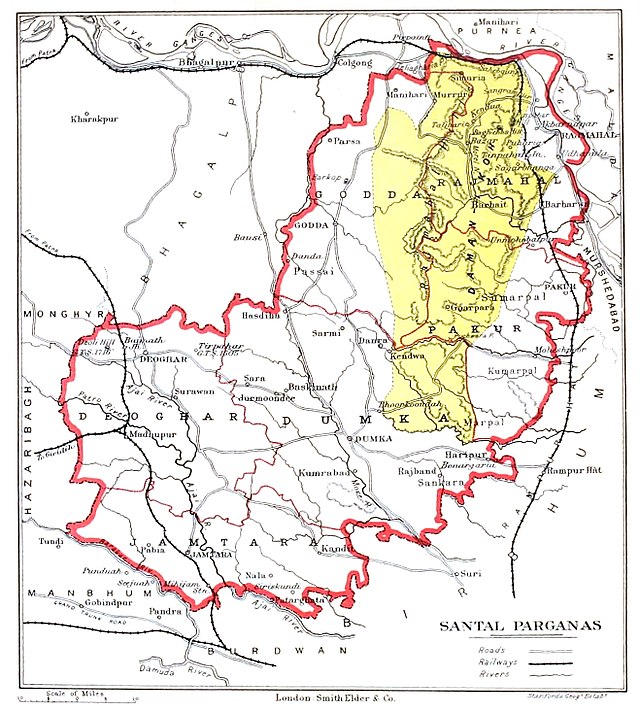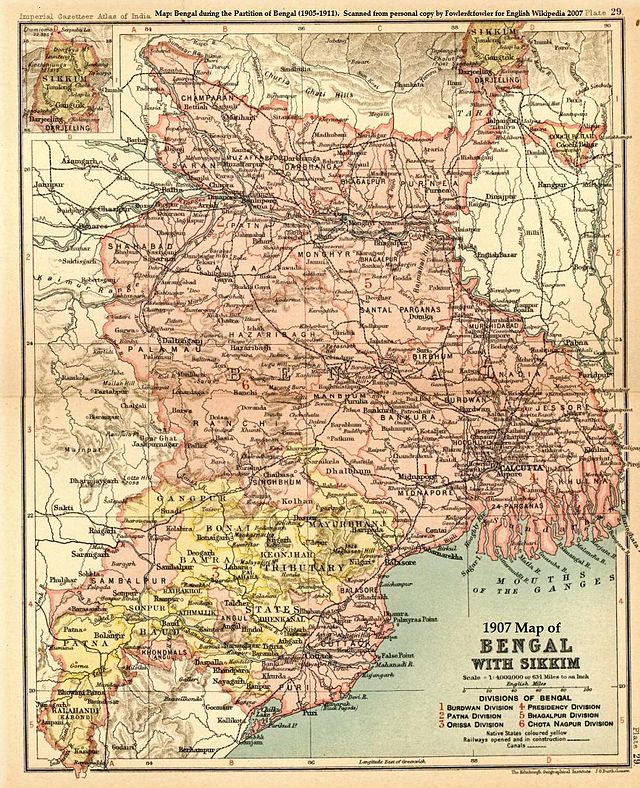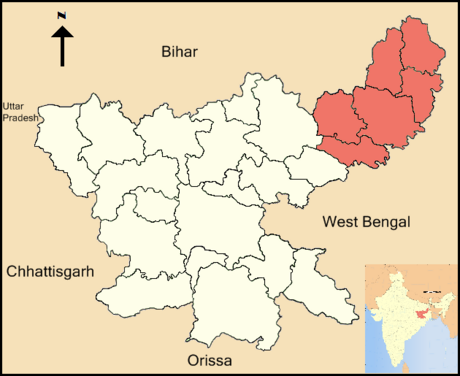Santal Pargana division constitutes six district administration units known as the divisions of Jharkhand state in eastern India.
This article needs additional citations for verification. (August 2016) |
Santal Pargana division | |
|---|---|
Division of Jharkhand | |
 Location of Santhal Pargana in Jharkhand | |
| Coordinates: 24°30′N 87°30′E | |
| Country | |
| State | Jharkhand |
| Established | 2000 |
| Headquarters | Dumka |
| Districts | Godda district, Deoghar, Dumka, Jamtara, Sahibganj, Pakur |
| Government | |
| • Commissioner | Shri Lalchand Dadel (IAS) |
| Area | |
• Total | 12,601 km2 (4,865 sq mi) |
| Population (2011) | |
• Total | 6,969,097 |
| • Density | 550/km2 (1,400/sq mi) |
Origin of name
Santal Pargana derives its name from two words: "Santal", a major inhabited tribe in the region and Pargana, a unit of administration in Persian language used mostly by medieval rulers.
Location
Santal Pargana is one of the divisions of Jharkhand. Its headquarters is at Dumka. Presently, this administrative division comprises six districts: Godda, Deoghar, Dumka, Jamtara, Sahibganj and Pakur.

History
This region is mentioned as Kajangala in different ancient literatures specially in Buddhist literatures. It is mentioned that the Chinese monk-traveller Xuanzang (Hiuen Tsang) travelled from Champa (recent Bhagalpur) to Kajangala and then proceeded to Pundravardhana (recent Bangladesh) in the 7th century AD. He says that the northern limit of its territory (means Sahebganj) was not very far from the Ganges. The forests to the south had plenty of elephants. The people were straight forward, talented and devoted to education.[1]
In the system of Permanent Settlement, British encourage paharia of Rajmahal hills to practice settled agriculture but they refused to cut trees. Then British officials attracted attention to Santals who were ready to clear the forests for settled agriculture. In 1832, a large number of area demarcated as Damin-i-koh. Santal from Cuttack, Dhalbhum, Birbhum, Manbhum, Hazaribagh migrated, clear forest tracts and started cultivating these lands as peasants. British collected tax from Santals as revenue. The imposition of taxes, exploitation by Zamindar and money lenders sparked Santal rebellion. The Sidhu and Kanhu Murmu, two brothers organized and led Santal inhabitants for the Santal Revolt (Santal Hul) against the Britishers but were defeated.[2][3][4][5][6] Their other siblings namely Chand Murmu, Bhairo Murmu, Phulo Murmu, Jhano Murmu also followed elder brothers leadership for fighting against injustice.


In 1855, during British India, Santal Parganas was created as a district, and was a part of the Bengal Presidency. Santal Parganas was a district, in undivided Bihar state, India. After formation of Jharkhand in became division. As a consequence of Santal uprising, the British passed the Santhal Parganas Tenancy Act ,1876 which offered some protection for the tribals against exploitation. It prohibits the sale of Adivasi land to non-Adivasis in the Santal Pargana region along present day Jharkhand's border with West Bengal. After Independence of India, the Santal Pargana Tenancy Act, 1949 is the first codified law of tenancy in Santal Pargana division of Jharkhand. When enacted, it supplemented existing British-era tenancy laws and codified some of the customary laws related to tribal land.
Demographics
Languages
It has a population of 6,969,097. Santali, Bengali and Hindi are mostly spoken national languages, followed by regional dialect Khorta.
Religion
Religions in Santhal Parganas 2011 census
Majority of the population follows Hinduism. Sari Dharam is followed by the Santal tribe residents and Sarna by other tribe. (The percentage will notified soon official sooner the Govt. Of India accomplishes recent Census).
References
Wikiwand in your browser!
Seamless Wikipedia browsing. On steroids.
Every time you click a link to Wikipedia, Wiktionary or Wikiquote in your browser's search results, it will show the modern Wikiwand interface.
Wikiwand extension is a five stars, simple, with minimum permission required to keep your browsing private, safe and transparent.
